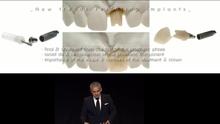-
0
Patient Assessment
- 0.1 Patient Demand
- 0.2 Anatomical location
-
0.3
Patient History
- 2.1 General patient history
- 2.2 Local history
-
0.4
Risk Assessment
- 3.1 Risk Assessment Overview
- 3.2 Age
- 3.3 Patient Compliance
- 3.4 Smoking
- 3.5 Drug Abuse
- 3.6 Recreational Drug and Alcohol Abuse
- 3.7 Condition of Natural Teeth
- 3.8 Parafunctions
- 3.9 Diabetes
- 3.10 Anticoagulants
- 3.11 Osteoporosis
- 3.12 Bisphosphonates
- 3.13 MRONJ
- 3.14 Steroids
- 3.15 Radiotherapy
- 3.16 Risk factors
-
1
Diagnostics
-
2
Treatment Options
-
2.1
Treatment planning
- 0.1 Non-implant based treatment options
- 0.2 Treatment planning conventional, model based, non-guided, semi-guided
- 0.3 Digital treatment planning
- 0.4 NobelClinician and digital workflow
- 0.5 Implant position considerations overview
- 0.6 Soft tissue condition and morphology
- 0.7 Site development, soft tissue management
- 0.8 Hard tissue and bone quality
- 0.9 Site development, hard tissue management
- 0.10 Time to function
- 0.11 Submerged vs non-submerged
- 0.12 Healed or fresh extraction socket
- 0.13 Screw-retained vs. cement-retained
- 0.14 Angulated Screw Channel system (ASC)
- 2.2 Treatment options esthetic zone
- 2.3 Treatment options posterior zone
- 2.4 Comprehensive treatment concepts
-
2.1
Treatment planning
-
3
Treatment Procedures
-
3.1
Treatment procedures general considerations
- 0.1 Anesthesia
- 0.2 peri-operative care
- 0.3 Flap- or flapless
- 0.4 Non-guided protocol
- 0.5 Semi-guided protocol
- 0.6 Guided protocol overview
- 0.7 Guided protocol NobelGuide
- 0.8 Parallel implant placement considerations
- 0.9 Tapered implant placement considerations
- 0.10 3D implant position
- 0.11 Implant insertion torque
- 0.12 Intra-operative complications
- 0.13 Impression procedures, digital impressions, intraoral scanning
- 3.2 Treatment procedures esthetic zone surgical
- 3.3 Treatment procedures esthetic zone prosthetic
- 3.4 Treatment procedures posterior zone surgical
- 3.5 Treatment procedures posterior zone prosthetic
-
3.1
Treatment procedures general considerations
-
4
Aftercare
Site development, soft tissue management
Key points
- Recession of the midfacial mucosa is a risk with immediate implant placement.
- The implications of implant-based therapy must be related to tissue biotypes.
- Presence or absence of buccal alveolar bone can be discerned by CBCT.
- A limited width of peri-implant keratinized mucosa (< 2 mm) correlates with an increased incidence of peri-implant mucositis.
- Preservation of postextraction sockets seems to be effective in reducing ridge resorption.
The alveolar ridge is a portion of the jaws that develop in conjunction with tooth eruption. The volume and the shape of the alveolar ridge are determined by the shape of the teeth and their axis of eruption. Following tooth extraction, the alveolar ridge undergoes a dimensional alteration of the buccal wall up to the 50%. It may compromise the functional and aesthetic outcomes. After extraction of a failing tooth, the soft and hard tissues may be already compromised by previous trauma, periodontal and/or endodontic infections. Many techniques have been proposed to regenerate atrophic alveolar jaws prior to implant. They are performed either in combination with graft procedures or during a second stage surgery. Guided bone regeneration seems to be effective in reducing ridge resorption. There is no consensus on the need to seal the socket or a specific technique or material. In a RCT, sealing the socket with a porcine collagen matrix or a epithelial connective tissue graft showed similar outcomes. Using a porcine collagen matrix simplifies the treatment since no donor site is needed.
Esthetic demands require the peri-implant soft tissue color and contour to be in harmony with the adjacent dentition particularly in the anterior area. Soft tissue defects around implant-retained restorations often result in extra long prosthetic crowns. Immediate implant placement and provisionalisation in conjunction with a connective tissue graft seems to be more likely to result in sufficient peri-implant tissue thickness to conceal underlying restorative materials than when performed without a connective tissue graft. In selected patients a flapless approach with immediate provisionalisation also leads to excellent results.




